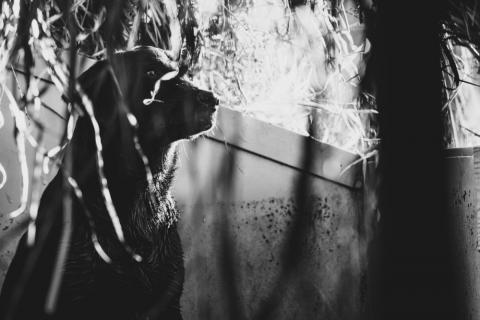Ron Jolly and Tes Randle Jolly | Originally published in GameKeepers: Farming for Wildlife Magazine. To subscribe, click here.

The feral hog invasion continues to spread across the United States. The economic and environmental destruction that accompanies these invasive animals, especially in new areas, has prompted national attention. Hunters, farmers, landowners, state and local agencies, federal authorities and companies are now addressing the issue. Education, public awareness, funding, innovative products and creative removal methods are key to control and eradication.
Valuable lessons have been learned that, if heeded properly, could finally turn the tide in the war against feral swine. Hogs are omnivorous, opportunistic feeders that go where their appetite takes them - it may be a farmer’s cornfield, a wildlife food plot or your backyard garden.
Forming a cooperative with neighbors who have a hog problem is imperative. Hogs are prolific breeders. You can kill all the pigs on your land but if your neighbor isn’t making the same effort, the problem will continue. Shooting, dogging and trapping are the most common methods of hog control. “Total sounder removal” through trapping is the recommended technique. Much success is being achieved using text and video enabled cameras with cell phone apps to monitor and remotely control trap drop-gates. However, there will always be some hogs that avoid traps, for various reasons. Some would say all feral hogs are “problems,” but in this case we’re referring to the ones that can’t be removed through our most conventional means.
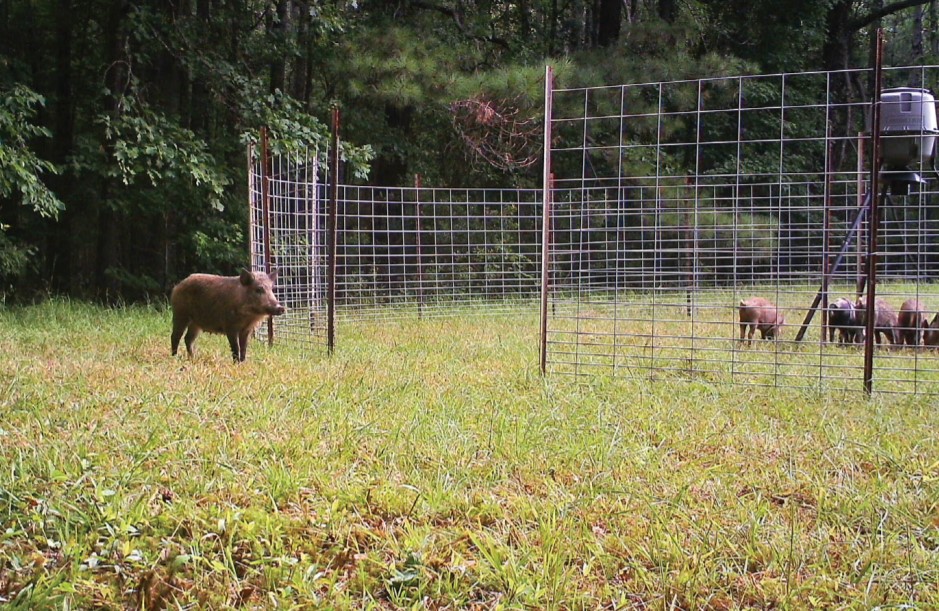
Understanding Educated Swine
Feral hogs are highly intelligent. Studies show hogs have similar cognitive abilities as dogs or chimpanzees. Simply put, pigs are not stupid. They live in socially complex family groups that work for the benefit and survival of individual members. They learn from their daily experiences, encounters and from other hogs. In short, feral hogs can learn from bad experiences. Total sounder removal trapping is designed to take out entire groups of pigs.
In reality, some trapping events will fail to capture the entire group, educating hogs outside the trap to associate it with danger. This can also happen when one sounder is caught in a trap and another is nearby. The sounder hears or sees the distressed, trapped hogs and reacts by avoiding trap setups.
Sometimes mature boars will flank a sounder of sows, boars and shoats that are acclimated to a trap. The trapper is faced with waiting for a boar that won’t enter the trap to let its guard down or drop the gate and capture the rest. This can result in wary boars that will not enter a trap.
Young, inexperienced pigs tend to enter traps first. Some sounders or family groups get educated to conventional traps when one of the group triggers the door before the entire group has entered. The family group is separated and any hogs on the outside quickly learn to avoid traps. Often, if a sow’s young are trapped, she will remain close. Every effort should be made when approaching a trap with captured hogs to stalk hunt your way to the site, ready to shoot any hogs lingering around the perimeter or nearby. Sows are the prime target in hog removal. Take them out first.
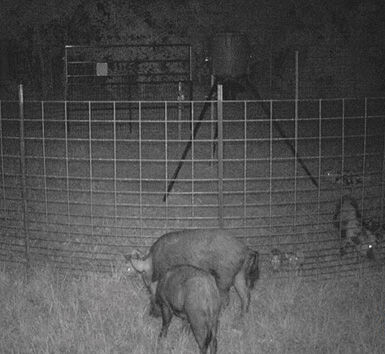
shy. The trap was triggered before all the hogs had
entered. Always approach a trap site carefully. The sows
remained on the perimeter and were shot after a careful
stalk using night-light mounted rifles.
Competition for bait can cause hogs to remain outside a trap. Large corral traps allow big sounders to enter. Inevitably, there is pushing and swiping by the dominant ones. Subordinate pigs may be bullied out of the trap and miss being captured. Now wary and conditioned to the danger, trap shy hogs in any of these instances require different tactics to kill.
Target Problem Hogs with High Tech Recon
To maintain an area’s hog population at status quo, a whopping 70% of the hogs must be removed annually. Such a goal requires a serious commitment. An efficient total sounder removal trapping program, conventional shooting and problem hog targeting are key. How do you know if you have “trap shy hogs?”
First, be patient. Like trapping, effective problem hog control requires time to develop a high percentage kill plan. Whether you’re trapping hogs using remote triggering or conventional methods, or trying to identify problem hogs, position a trail camera with a wide view of the trap so it provides arrival times, a head-count, gender makeup and age classes of visiting pigs. Try setting the camera to interval shooting if the trap is large.
Give hogs several days to get comfortable going in and out of the trap. Given enough time watching its herd mates feed, the desire to eat may overcome a trap shy pig’s wariness. If not, you’ll have identified the ones that will need to be eliminated by other means.
Be methodical - keep a journal. Note which hogs remain outside as others go in to feed, and any that simply visit the area without entering the trap. Video footage is an invaluable recon tool. Consider setting the camera to record short clips once hogs find the trap. A sounder’s direction of approach can be determined and which hogs are a potential problem by their behavior and degree of wariness. Use this knowledge to develop a strategy.
Read the sign. Once problem hogs are identified around a trap, back-track their direction of approach. Scout for sign, trails, bedding areas, available food sources, rooting, rubs, wallows and droppings. Place a trail camera along a fresh trail or wallow to monitor hog movement and activity.
Hogs are predictable in a couple of ways. They can’t sweat to control body temperature so wet or swampy areas containing water are good places to begin, especially during hot weather. Pay attention to wet weather forecasts during dry periods. Hogs often go on rooting forays soon after rain showers. In upland areas check wet weather drainages, low spots and draws in timbered areas for rooting sign. When legal, combine scouting and still hunting to increase the chance of reducing the hog population.
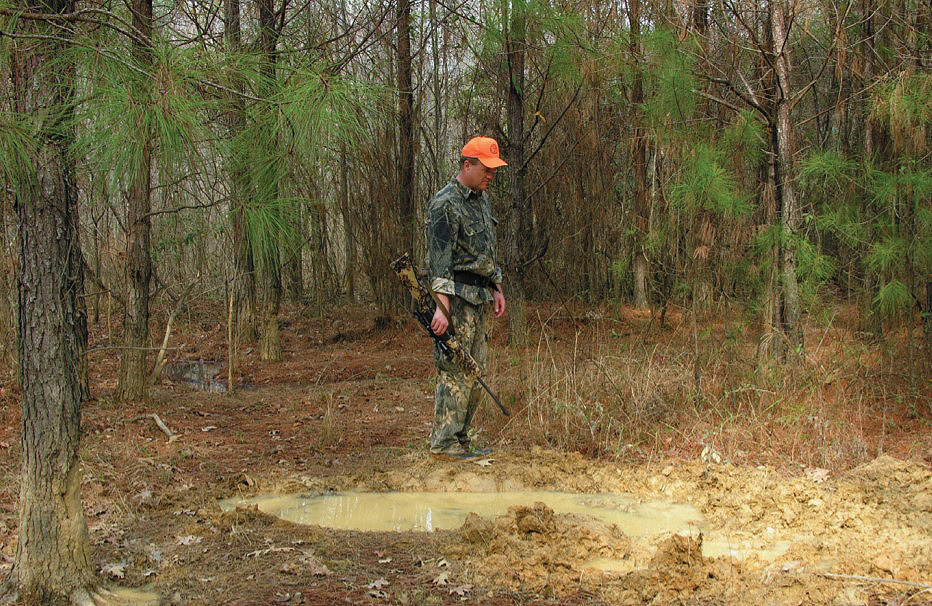
Position the Target
Check your local hunting regulations with regards to required permits, licensing, season dates, baiting, hunting methods and night hunting before planning a hunt strategy. Depredation permits are typically available to landowners whose property is sustaining economical and environmental damage. If baiting hogs is legal in your area, locate bait sites away from traps and near an active trail, wallow, feeding area suitable for shooting. Choose a location that can be viewed from a distance. Pay close attention to prevailing wind direction and how you’ll stalk in range or position a stand or ground blind.
Baiting is our preferred and most effective method for killing problem hogs. The first group of hogs we helped a friend trap were hog-tied inside the trap and removed before they were killed to avoid contaminating the trap with blood and scent. The pigs were put in a truck bed that contained spilled corn. To our amazement, the hogs, lying on their sides, riding to their execution, began eating spilled corn. We learned then, a hog’s big appetite can be exploited. Be aware of seasonal food sources, whether native or agriculture. When food is abundant, hogs are harder to entice. Take advantage of scarce food supply periods to target problem hogs.
Take advantage of a hog’s highly developed sense of smell. They can be drawn to an area using feed that emits a strong odor. Companies like Big and J™ produce a scent attractant feed. Other companies make additive syrups that feature blueberry, strawberry, apple, persimmon and other flavors that appeal to a hog’s olfactory senses. Corn mixed with yeast or beer, water and Jell-O powder makes a potent home brew that will attract hogs. Set the covered bucket in the sun to ferment - the more pungent, the better. Spread or dig a hole and fill it with the scented feed. Mount a trail camera to monitor activity.
Timed spin feeders are effective bait distributors for hunting problem hogs. Without a trap enclosing them, even problem hogs become comfortable at the prospect of a dependable food source. Set the timer to spin during legal hunting hours early and/or late in the day when hogs are active. If night hunting is legal, consider setting it to spin after dark when hogs are most active. Place a trail camera on the site or mounted to the feeder. Be patient, gather intel, then plan your hunt method and strategy accordingly.
If you’re stalking, once hogs are coming to a baited site you’ll want them to spend enough time for you to approach within range for a shot. Our favorite tactic is to bury the feed and string a few lines of corn on the ground. Use a sharpshooter shovel or post hold digger to dig holes approximately one foot deep. Fill each hole with bait or shelled corn and toss a handful of loose dirt in each. This accomplishes several things. First, hogs have to dig for the buried food and remain on location longer to clean up the food. Second, deer and other critters won’t have easy access assuring there will be food on site when hogs come to investigate. Finally, in a multiple hog situation, there will be less fighting over feed among mature hogs if each has a corn-filled hole to itself. Provide a constant food supply and deliver it at the same time of day. Hogs will pattern people, too.
Place a trail camera on the site to monitor activity. Trail cameras that are text capable make effective undercover “spies.” They detect motion at the site and send a text message containing a time stamped photo of what initiated the message. Again, be patient and let the hog(s) get comfortable with the new food supply. Simply monitor your text messages from hunting camp or a nearby location and have your gear ready to go.
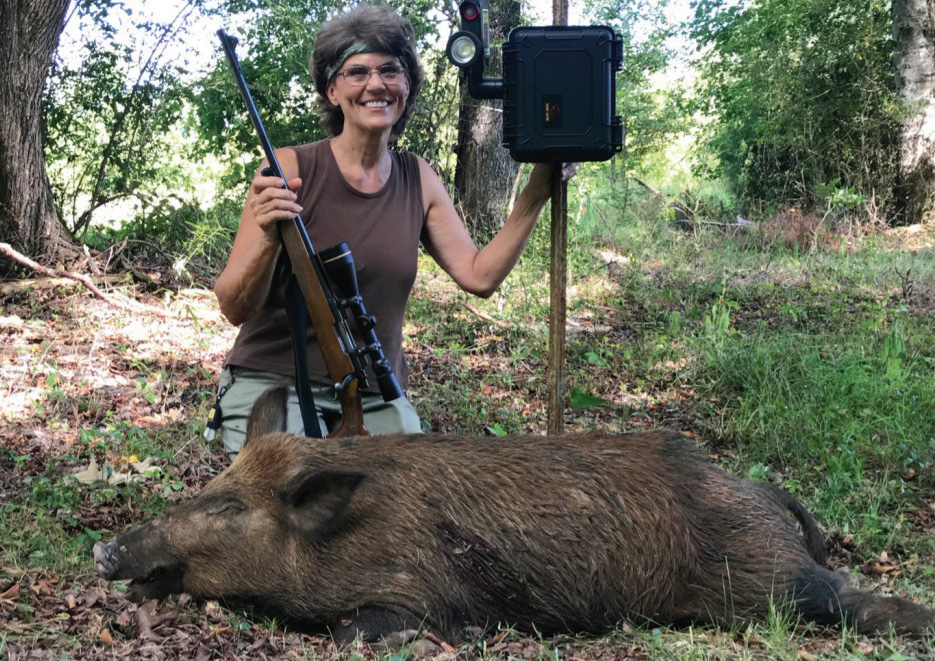
Take Them Out!
Pop-up blinds or permanent stands overlooking a baited area are effective tools in the elimination of problem pigs. They offer cover and comfort if there’s a long wait for hogs to arrive. Some hunters take a position far enough away from the bait site to not be detected by visiting animals yet see the light when it is activated. A scoped rifle is the tool of choice in these situations but a shotgun with buckshot is also effective if you are set up or can stalk within range of multiple hogs. Inviting your spouse or a buddy along will increase the opportunity to take multiple hogs. Practice a countdown sequence to synchronize your shots.
Night vision and thermal optics give shooters a definite advantage in the darkness. Feral hogs respond to hunting pressure, high temperatures and food availability by becoming nocturnal. Modern thermal and night vision optics allow shooters to cheat the darkness and hunt problem hogs, particularly in open areas.
The one drawback to thermal or night vision optics is price. Companies like Moultrie®, Elusive Wildlife Technologies, LP and Slow Glow LED Hunting Lights offer affordable light solutions for night hunting hogs. The Moultrie Feeder Hog Light emits a green light that is not readily detectable by hogs. It’s designed to mount on a feeder or overhead limb and utilizes four C batteries or an optional 6-volt external battery for extended power.
The Moultrie Light offers several operational choices – “On/Off,” “Dusk” for continuous dusk to dawn light, and “Motion” that triggers the light on when movement is detected within about a 30 foot area. Each has a high or low power setting.
The Slow Glow RMT features a “training” mode that keeps the light at 5% intensity all night until motion is detected, training hogs to a non-threatening low lit area. Motion triggers gradual illumination to 60% over a 2 minute period. The remote control allows you to control the light from 100 yards away.
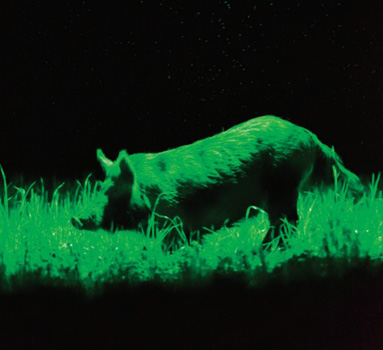
attached to a feeder. Green light typically doesn’t spook
hogs as this photo demonstrates.
Elusive Wildlife offers gun or bow mounted lights, feeder lights and infrared lights.
Thermal and night vision optics give you the option of covering ground in search of hogs. Feeder and weapon mounted lights are better suited for targeting problem hogs that are coming to a feeder or bait station where they can be stalked or hunted from a stand or blind.
Final Thoughts
The feral hog problem has become so acute that the federal government has tackled the issue in the latest version of the Federal Farm Bill. This legislation appropriates $75 million over the next five years for hog control. That sounds like a huge amount of funding but many experts agree this is only a beginning and believe it will require a comprehensive plan that puts all stakeholders on the same page to finally begin eradicating feral hog populations from large tracts of land.
Like it or not, feral hogs are here to stay. In the meantime, it is left to us as gamekeepers to do the best we can to manage the situation. Ask any landowner or manager who’s dedicated to feral hog control and he will tell you that eliminating problem pigs, or any pigs, is not so much a sport, as it is a mission. It requires a long term commitment of time, money, diligent year round scouting/monitoring and using every tactic at hand to kill as many hogs as possible. They truly are the enemy where left unchecked and native wildlife and plant life will continue to suffer.

















